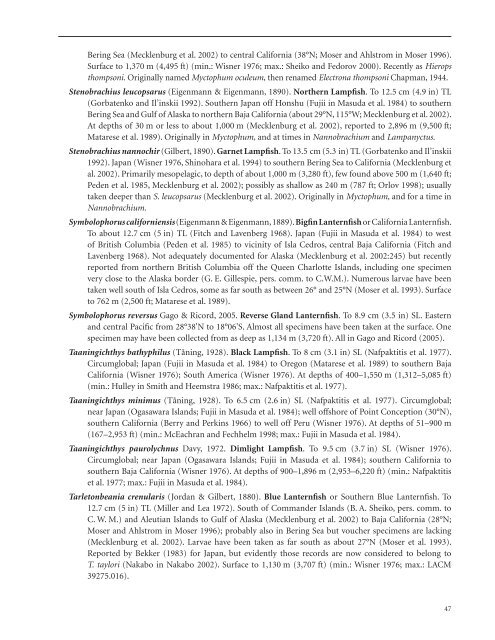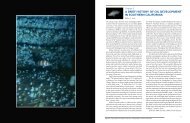checklist (pdf) - The Love Lab - University of California, Santa Barbara
checklist (pdf) - The Love Lab - University of California, Santa Barbara
checklist (pdf) - The Love Lab - University of California, Santa Barbara
Create successful ePaper yourself
Turn your PDF publications into a flip-book with our unique Google optimized e-Paper software.
Bering Sea (Mecklenburg et al. 2002) to central <strong>California</strong> (38°N; Moser and Ahlstrom in Moser 1996).<br />
Surface to 1,370 m (4,495 ft) (min.: Wisner 1976; max.: Sheiko and Fedorov 2000). Recently as Hierops<br />
thompsoni. Originally named Myctophum oculeum, then renamed Electrona thompsoni Chapman, 1944.<br />
Stenobrachius leucopsarus (Eigenmann & Eigenmann, 1890). Northern Lampfish. To 12.5 cm (4.9 in) TL<br />
(Gorbatenko and Il’inskii 1992). Southern Japan <strong>of</strong>f Honshu (Fujii in Masuda et al. 1984) to southern<br />
Bering Sea and Gulf <strong>of</strong> Alaska to northern Baja <strong>California</strong> (about 29°N, 115°W; Mecklenburg et al. 2002).<br />
At depths <strong>of</strong> 30 m or less to about 1,000 m (Mecklenburg et al. 2002), reported to 2,896 m (9,500 ft;<br />
Matarese et al. 1989). Originally in Myctophum, and at times in Nannobrachium and Lampanyctus.<br />
Stenobrachius nannochir (Gilbert, 1890). Garnet Lampfish. To 13.5 cm (5.3 in) TL (Gorbatenko and Il’inskii<br />
1992). Japan (Wisner 1976, Shinohara et al. 1994) to southern Bering Sea to <strong>California</strong> (Mecklenburg et<br />
al. 2002). Primarily mesopelagic, to depth <strong>of</strong> about 1,000 m (3,280 ft), few found above 500 m (1,640 ft;<br />
Peden et al. 1985, Mecklenburg et al. 2002); possibly as shallow as 240 m (787 ft; Orlov 1998); usually<br />
taken deeper than S. leucopsarus (Mecklenburg et al. 2002). Originally in Myctophum, and for a time in<br />
Nannobrachium.<br />
Symbolophorus californiensis (Eigenmann & Eigenmann, 1889). Bigfin Lanternfish or <strong>California</strong> Lanternfish.<br />
To about 12.7 cm (5 in) TL (Fitch and Lavenberg 1968). Japan (Fujii in Masuda et al. 1984) to west<br />
<strong>of</strong> British Columbia (Peden et al. 1985) to vicinity <strong>of</strong> Isla Cedros, central Baja <strong>California</strong> (Fitch and<br />
Lavenberg 1968). Not adequately documented for Alaska (Mecklenburg et al. 2002:245) but recently<br />
reported from northern British Columbia <strong>of</strong>f the Queen Charlotte Islands, including one specimen<br />
very close to the Alaska border (G. E. Gillespie, pers. comm. to C.W.M.). Numerous larvae have been<br />
taken well south <strong>of</strong> Isla Cedros, some as far south as between 26° and 25°N (Moser et al. 1993). Surface<br />
to 762 m (2,500 ft; Matarese et al. 1989).<br />
Symbolophorus reversus Gago & Ricord, 2005. Reverse Gland Lanternfish. To 8.9 cm (3.5 in) SL. Eastern<br />
and central Pacific from 28°38'N to 18°06'S. Almost all specimens have been taken at the surface. One<br />
specimen may have been collected from as deep as 1,134 m (3,720 ft). All in Gago and Ricord (2005).<br />
Taaningichthys bathyphilus (Tåning, 1928). Black Lampfish. To 8 cm (3.1 in) SL (Nafpaktitis et al. 1977).<br />
Circumglobal; Japan (Fujii in Masuda et al. 1984) to Oregon (Matarese et al. 1989) to southern Baja<br />
<strong>California</strong> (Wisner 1976); South America (Wisner 1976). At depths <strong>of</strong> 400–1,550 m (1,312–5,085 ft)<br />
(min.: Hulley in Smith and Heemstra 1986; max.: Nafpaktitis et al. 1977).<br />
Taaningichthys minimus (Tåning, 1928). To 6.5 cm (2.6 in) SL (Nafpaktitis et al. 1977). Circumglobal;<br />
near Japan (Ogasawara Islands; Fujii in Masuda et al. 1984); well <strong>of</strong>fshore <strong>of</strong> Point Conception (30°N),<br />
southern <strong>California</strong> (Berry and Perkins 1966) to well <strong>of</strong>f Peru (Wisner 1976). At depths <strong>of</strong> 51–900 m<br />
(167–2,953 ft) (min.: McEachran and Fechhelm 1998; max.: Fujii in Masuda et al. 1984).<br />
Taaningichthys paurolychnus Davy, 1972. Dimlight Lampfish. To 9.5 cm (3.7 in) SL (Wisner 1976).<br />
Circumglobal; near Japan (Ogasawara Islands; Fujii in Masuda et al. 1984); southern <strong>California</strong> to<br />
southern Baja <strong>California</strong> (Wisner 1976). At depths <strong>of</strong> 900–1,896 m (2,953–6,220 ft) (min.: Nafpaktitis<br />
et al. 1977; max.: Fujii in Masuda et al. 1984).<br />
Tarletonbeania crenularis (Jordan & Gilbert, 1880). Blue Lanternfish or Southern Blue Lanternfish. To<br />
12.7 cm (5 in) TL (Miller and Lea 1972). South <strong>of</strong> Commander Islands (B. A. Sheiko, pers. comm. to<br />
C. W. M.) and Aleutian Islands to Gulf <strong>of</strong> Alaska (Mecklenburg et al. 2002) to Baja <strong>California</strong> (28°N;<br />
Moser and Ahlstrom in Moser 1996); probably also in Bering Sea but voucher specimens are lacking<br />
(Mecklenburg et al. 2002). Larvae have been taken as far south as about 27°N (Moser et al. 1993).<br />
Reported by Bekker (1983) for Japan, but evidently those records are now considered to belong to<br />
T. taylori (Nakabo in Nakabo 2002). Surface to 1,130 m (3,707 ft) (min.: Wisner 1976; max.: LACM<br />
39275.016).<br />
47




